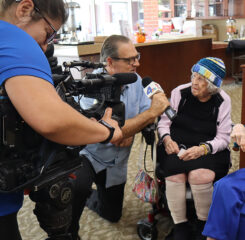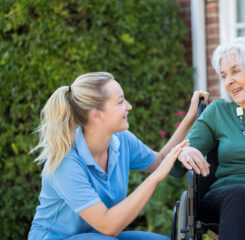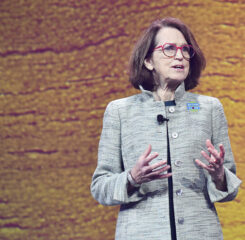CAST Expands Broadband in Affordable Housing Resources
LeadingAge CAST has released its new Broadband in Affordable Housing resource, which will help organizations to understand the process for bringing broadband connectivity to their communities affordably. This resource can be especially valuable for affordable senior housing providers and their residents.
In addition to the Broadband in Affordable Housing white paper released last month, the resource now includes an interactive guide and four case studies. The interactive guide will help organizations to use learnings from the white paper to plan for, design, select, and implement broadband connectivity. The case studies, summarized below, show real-life examples of how providers have implemented internet connectivity and made it more affordable or free to eligible low-income residents in their communities.
Case Studies
Adding Free Campus-Wide Connectivity to Tax-Credit Residents through a Redevelopment Project: During a rehabilitation, the nonprofit Lady of Angels Apartments, Inc. and management company/co-developer LSC Service Corp. installed Wi-Fi and hardwired internet in units, secure Wi-Fi in common areas, and a computer lab in the Franciscan Village Apartments. They used a low-income housing tax credit (LIHTC) to modernize buildings and implement campus-wide Wi-Fi that is included in rents for all residents/tenants living in the affordable units.
Outcomes:
Residents with smartphones, tablets, and smart televisions can use the Wi-Fi, which is effectively free for low-income residents who qualify for subsidy. All residents, including those ineligible for affordable units or subsidies, save money on cable and internet compared to the costs of contracting those services on their own. The internet provides increased access to information and services, including healthcare, government programs, state programs, local programs, online grocery ordering, video conferencing with loved ones, etc.
Providing Free Campus-Wide Connectivity to Low-Income Residents through a Redevelopment Project: The nonprofit Bay Interfaith Housing, Inc. also partnered with management company LSC Service Corp. Together they used an LIHTC to modernize the Knickerbocker Senior Apartments, which had 168 units of affordable housing at the time.
As with the case study above, this project included implementing campus-wide Wi-Fi included in rents for all residents/ tenants living in the affordable units. It too yielded positive outcomes, demonstrating the strength of this model.
Improving Well-being and Social Connections Through Technology for California Seniors Isolated by COVID-19: At Eskaton and Front Porch, Lighthouse for Older Adults deployed property-wide Wi-Fi with the initial broadband connectivity preference for fiber, and secondarily for high-speed coax, depending on availability of services. Lighthouse for Older Adults worked closely with CDW Healthcare on broadband infrastructure construction, ultimately for six affordable housing communities. The pilot distributed Google Hub Max devices to residents and staff, connected devices to residential Wi-Fi, and deployed mobile/cellular hotspots for temporary internet connectivity.
Outcomes:
Initial outcomes found that all 20 participants in the Rapid Pilot Deployment (RPD) felt more socially connected: 95% said their Google devices helped them stay connected with family and friends, and 90% felt less lonely. In addition, 90% of participants reported feeling “somewhat” or “very” confident using their devices, and over half used their devices at least once per day. While video calls were the most popular feature, many participants also used the devices to seek information (80%) or listen to music (75%).
Bringing Fiber Internet to Affordable Housing Residents: In this new construction project involving U.S. Department of Housing & Urban Development funds, an investment from Givens Affordable Communities paid for infrastructure. The partner internet service provider, ERC Broadband, offered five years of 1Gbps internet service for the fiber build-out cost of $20,000. Givens Affordable Communities — Givens Gerber Park provided triple play services for a fee, including free Wi-Fi and internet access, plus computers for use in common areas.
Outcomes:
Bulking phone, internet, and cable service with local providers saved each resident at least $348 per year. Residents subscribing to broadband internet saved at least $300 per year per resident. A large portion of the revenue generated ($44,000 in 2021) is reinvested in community projects that benefit residents, including technology-related educational materials, scam prevention, internal community channel and programming, and hardware such as library computers and iPads for community nursing services and telemedicine visits for residents.
To learn more, be sure to explore the Broadband in Affordable Housing resource.

Most Recommended
November 08, 2024
 HOTMA: New Rules for Housing
HOTMA: New Rules for Housing
November 06, 2024
 Colleagues on the Move, November 6, 2024
Colleagues on the Move, November 6, 2024
November 06, 2024
 Analysis: What Does the Final CY2025 Home Health Rule Include?
Analysis: What Does the Final CY2025 Home Health Rule Include?
October 29, 2024
Katie Smith Sloan Urges Members to Build a Movement, Take Action
Recently Added
December 10, 2024
4 Top Tech Themes from 2024
December 09, 2024
 Analysis: What’s Changing with the Home Health CAHPS Survey?
Analysis: What’s Changing with the Home Health CAHPS Survey?
December 09, 2024



